|
Taliban attacks three cell sites in Afghanistan because demands weren't followed
Update - 3.4.08: Although there have been three attacks on cell phone tower sites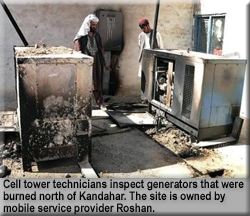 after a Taliban demand that all telephone signals be turned off during the evening and overnight, the damage has only mildly disrupted cell service in Afghanistan and the sites are expected to be in service in the near future. after a Taliban demand that all telephone signals be turned off during the evening and overnight, the damage has only mildly disrupted cell service in Afghanistan and the sites are expected to be in service in the near future.
A reported attack on a tower site in Kandahar yesterday followed one on February 29 and another explosion at a cell tower compound on March 1. There have been no reported injuries in the incidents.
The towers were not damaged, but walls and equipment within the compounds received some harm.
_______________________________________________________________
February 25, 2008 - According to press reports, Taliban insurgents will attack and blow up cell towers in Afghanistan if wireless carriers in the war torn country don't turn off their networks at night.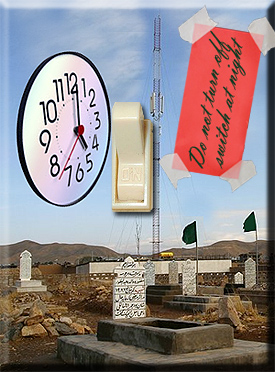
"If those companies do not stop their signal within three days, the Taliban will target their towers and their offices," Taliban spokesman Zabiullah Mujaheed said.
The Taliban said that Afghanistan's four mobile phone companies, Wireless Communication Company, Areeba, Etisalat and Roshan, should stop operating between 5:00 p.m. local time and 7:00 a.m. the following morning.
Militants have threatened the companies in the past, accusing them of colluding with the US and other forces. They say that US and other foreign troops are using the signals to track down insurgents.
Communication experts say the US military uses satellites to pick up mobile signals and does not need the help of the cell carriers.
With 700 million dollars of investment, the burgeoning communications industry is one of the biggest development projects in Afghanistan since the fall of the Taliban regime in a US-led invasion in late 2001. According to the country's telecommunications ministry, over five million Afghans are currently using mobile phones.
|
New addendum in the works to 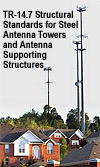
ANSI/TIA-222-Revision G
February 28, 2008 - Almost a year after the release of ANSI/TIA-222-G, Structural Standard for Antenna Supporting Structures and Antennas, work has begun on the latest addendum to one of TIA's most popular and influential standards, by the TR-14.7 Structural Standards for Steel Antenna Towers and Antenna Supporting Structures Engineering Subcommittee.
Please see: Invite offered to tower siting community |
|
FCC Commissioner welcomes the decision, but
Court's FCC split avian ruling seen as a blow to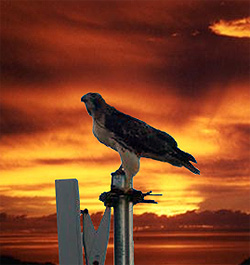 the tower siting community the tower siting community
February 20, 2008 - In a divided 2-1 decision, the U.S. Court of Appeals for the District of Columbia Circuit yesterday dealt a blow to the tower siting industry when it sided with conservation groups that claimed the Federal Communications Commission violated government rules by approving communications towers that threaten migratory birds.
The FCC previously rejected the groups' contention that it illegally licensed 6,000 towers in the Gulf Coast, from Texas to Florida, without first assessing the potential impact on migratory birds. The agency said the groups failed to make any specific allegations related to individual towers as required by its rules.
"We vacate the order because the commission failed to apply the proper NEPA [National Environmental Policy Act] standard, to provide a reasoned explanation on consultation under the ESA [Endangered Species Act], and to provide meaningful notice of pending tower applications," stated the court's decision. The court also ruled that the FCC didn't justify why it did not use federal wildlife experts to assess the environmental threat.
Earthjustice, the public interest law firm that argued the case for the American Bird Conservancy and the Forest Conservation Council, said that they thought it is a very significant ruling because it requires the FCC to carefully consider the environmental impact of communications towers on bird population, and it ensures the public will have timely notice of applications for tower permits.
Please see, Circuit Judge: Lawsuit is "unripe".
|
MidAmerica Tower Service proves it can be done as…
OSHA chief presses the tower industry
to get off of the top ten fatality list
February 18, 2008 – While the PCIA – Wireless Infrastructure Association show was winding down last October, if you stepped into an adjacent conference room you would have heard the head of the Occupational Safety and Health Administration tell a Florida human resources conference that he had “irrefutable evidence that 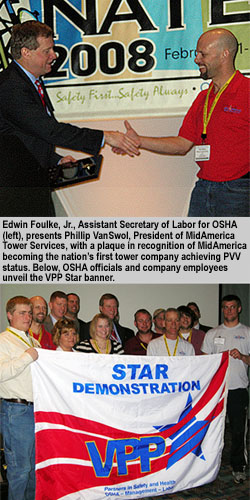 protecting employees is good for business.” protecting employees is good for business.”
The economies of a safe workplace is a frequent thread in presentations made by Edwin Foulke, Jr., Assistant Secretary of Labor for OSHA, a topic he touched upon at the National Association of Tower Erectors’ conference on February 13, 2008. He also heralded OSHA’s web site as an excellent resource for occupational safety information.
During many of his speeches following his confirmation by the Senate on March 15, 2006, he credentialed his ability to lead the 2,200 employee group by informing conference attendees of his prior employment as a partner with the law firm of Jackson Lewis, LLP in Greenville, S.C., and Washington, D.C., where he chaired the firm’s OSHA practice group.
However, during his NATE presentation, he passionately departed from his customary talk by reminding audience members, “Unfortunately, tower climbing does remain the most hazardous industry, or maybe the most dangerous job in America."
In addition, Secretary Foulke sadly reflected upon a personal involvement he had with a tower erection company that had a fatality while he was in private practice as head of the firm’s tower erection group. Please see: He still sees the fatality. |
|
Three women, two men indicted after stealing copper from more than 100 cell sites
February 11, 2008 - An extensive FBI investigation has resulted in an indictment against five Virginia residents who allegedly stole copper grounding from cell sites in Virginia and North Carolina.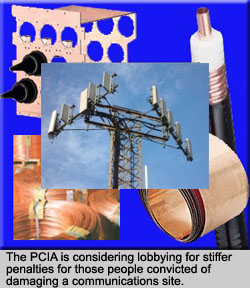
Keith Arlan Pickens, 32; Heather Maureen Yerigan, 27; Dale C. Merrill, 36; Marina Bernadette Long, 34; and Sarah Jo Carr, 25, were all named as defendants in a 12-count indictment. The first count of the indictment charges all five with conspiracy and the remaining substantive counts charge malicious destruction of communication lines and systems. Chuck Rosenberg, United States Attorney for the Eastern District of Virginia and Alex J. Turner, Special Agent in Charge, Federal Bureau of Investigation, Norfolk Field Office, announced the indictment after it was opened last week.
The indictment alleges that from January of 2007 through July of 2007, the defendants stole copper grounding bars and copper wiring from cellular telephone towers and thereafter sold the stolen copper to local salvage dealers. The defendants entered over 100 cellular tower sites located in 17 different jurisdictions in the Eastern District of Virginia and eastern North Carolina. Upon entering onto the tower sites, they forcibly removed the copper grounding bars and copper wiring, thereby injuring the tower sites and telephone equipment, and potentially impairing cellular communications systems in the affected areas. The damage to the cellular equipment is estimated to be approximately $270,000.
The defendants each face a maximum of five years in prison for the conspiracy charge and ten years for each substantive count.
The investigation of the case was handled by the Norfolk Field Office of the Federal Bureau of Investigation with assistance from 16 law enforcement organizations.
Earlier this month, 140 people were busted in a copper fencing ring sting in California's Silicon Valley. In Maryland, lawmakers are considering a bill that forces junk dealers to register the copper they purchase. The Illinois state legislature is considering an increase in penalties for stealing copper from cell towers.
PCIA - The Wireless Infrastructure Association is considering advocating for stiffer penalties for those convicted of damaging communications sites.
|
|
Tower crew bolts away from tornado during storms that kill more than 48 in four states
February 6, 2008 - Instead of running transmission lines, four members of a tower crew from Chattanooga were forced to run from an approaching tornado in 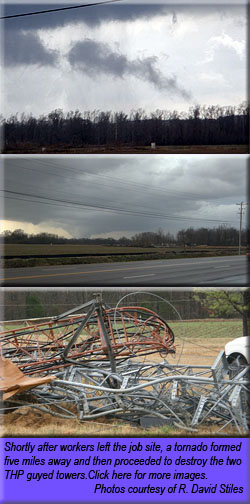 Tennessee, one of more than 50 that touched down as a series of thunderstorms, rare for the winter season, rolled through Kentucky, Tennessee, Mississippi and Arkansas last night, killing at least 48 people in its wake. Tennessee, one of more than 50 that touched down as a series of thunderstorms, rare for the winter season, rolled through Kentucky, Tennessee, Mississippi and Arkansas last night, killing at least 48 people in its wake.
Crew members from Lit Systems, Inc., R. David Stiles, Jason Mills, Shawn Mitchell, and Jason Magdelino, had just completed rigging a newly installed 410-foot guyed tower manufactured by Sabre Towers and Poles in preparation to install 11 transmission lines and nine antennas for the Tennessee Department of Transportation and the Tennessee Highway Patrol.
Although there were no alerts of an approaching tornado, threatening clouds prompted the crew to shut down the job site for the day. While they were loading tools into a work trailer, a bolt of lightning hit the top of the tower, causing the technicians to bolt to their vehicles and leave the Arlington site.
After traveling approximately five miles, Stiles and Mills sat in their truck in awe as they watched a funnel cloud begin to form about a mile away. Veiled by an ominous greenish tint, the storm clouds began to rotate, then stop, fill again, and repeat the process a number of times for 15 minutes until the tornado was fully formed with a half mile spread at its base, according to Stiles who photographed its formation.
At approximately 5:45 p.m. central, the tornado moved directly towards the Osbornetown Road tower site, located approximately 25 miles east of Memphis.
A TDOT employee who lives near the site contacted the Highway Patrol, informing them that the tower had been destroyed by the tornado. The Sabre structure had been built next to an existing 350-foot PiRod guyed tower with interlaced guy wires. It too was torn from its base and lay twisted in an open field. Both structures' equipment buildings were damaged.
The tower served as a main communications hub in the Memphis area for the THP and its collapse added to the already taxed communications system utilized by emergency services.
Chad Stiles, president of Lit Systems, Inc., said that his company would be installing a temporary 320-foot guyed tower to get the THP back on the air.
For more photos of the devastation, please click here.
|
Washington board asked to interpret legislation that would halt tower design work by P.E.s
February 6, 2008 - Professional engineers that currently design communications 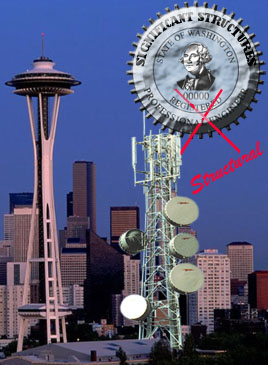 structures in Washington may be prohibited from providing those services after June, or at the latest, December 31, 2010. structures in Washington may be prohibited from providing those services after June, or at the latest, December 31, 2010.
During the Washington State 2007 Legislative Session, Substitute Senate Bill 5984, allowing only structural engineers to provide engineering services for "significant structures", was passed by the House 98 to 0 and signed by Gov. Christine Gegoire on April 21.
The provisions of the bill, effective July 1, detailed many structures that were deemed to be significant such as buildings housing explosives, hospitals, fire and police stations, and government communications centers. Among others, it also listed "Structures exceeding 100 feet in height above average ground level."
Please see: Standard group objects |
|
Fatality in Missouri said not to be industry related
February 1, 2008 - Springfield, MO police have identified a man who either fell or jumped to his death from a downtown cell phone tower Wednesday as Michael E. Young, 45, of Springfield. Rumors throughout the industry incorrectly stated that the decedent was a tower worker.
Young was spotted climbing the Alltel tower, at Benton Avenue and Tampa Street, about 3:22 p.m. Wednesday.
Police used loud speakers to try to talk him down from about the 200-foot level on the self supporting tower, but were unsure if he heard them because of the high winds.
At about 4:30 p.m., Young fell or jumped, falling about 50 feet before becoming entangling in the tower's structure. Shortly afterward, he fell again. His foot caught in a brace of the tower and he hung upside down about 100 feet from the ground.
|
|
Dominating Manhattan's skyline, country's largest radome will be 408 feet, but is years away
February 1, 2008 - Companies that design, manufacture or install broadcast communications antennas will be looking for opportunities to belly up to the bidding and bragging bar to offer their services to provide the nation's largest TV broadcast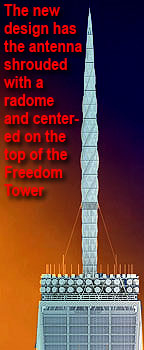 antenna that is encased by a radome, following an announcement from the Freedom Tower's architects that the antenna atop the structure will be part of the tower's design. antenna that is encased by a radome, following an announcement from the Freedom Tower's architects that the antenna atop the structure will be part of the tower's design.
The designer of the master plan for the 16-acre former World Trade Center site in New York had previously promoted an open off-center antenna as the crowning facet of architect David Childs' Freedom Tower design. However, a consortium of broadcast engineers of the Metropolitan Television Alliance said that putting the mast off-center would interfere with their ability to transmit their signal from the 1,776-foot building.
After further review, Childs now says that those ideas, which exposed the actual antenna to the air, were impractical. He said that the more open designs would cause the potential for ice to accumulate and fall to Manhattan streets and make the mast impossible to maintain at such a height.
The Port Authority of New York and New Jersey, which owns the $2.9 billion Freedom Tower, and architects Skidmore Owings & Merrill have come to an agreement upon what the antenna will look like. The mast will constitute the project's top 408 feet.
The current design, pictured above, done in consultation with sculptor Ken Snelson, shrouds the antenna in a radome that is invisible to the broadcast signals that easily transmit through it.
The Metropolitan Broadcast Alliance, a consortium of 13 TV stations that will be on the Freedom Tower antenna, is currently negotiating with the Port Authority on lease rental rates and other contract concerns. A contract with the broadcasters is anticipated to net about $10 million a year in annual rent. The antenna is expected to cost more than $20 million to build.
Freedom Tower's radome is 74 feet higher than CN Tower's
In an industry whose ego feeds off of superlatives, some observers believe that the Freedom Tower's radome will be the tallest in the world, surpassing the CN Tower in Toronto, Canada.
The CN Tower's management company said that the structure is owned by their  Federal Government and they could not release proprietary information regarding the radome's size.However, an estimate was arrived at by scaling an available drawing by Toronto engineer Simon Weisman, President of Weisman Consultants Inc. , showing the radome above the space deck to be approximately 334 feet in height. Federal Government and they could not release proprietary information regarding the radome's size.However, an estimate was arrived at by scaling an available drawing by Toronto engineer Simon Weisman, President of Weisman Consultants Inc. , showing the radome above the space deck to be approximately 334 feet in height.
Although the CN Tower will maintain bragging rights for being the tallest building in the world at 1,815 feet, 39 feet taller than the Freedom Tower, the New York structure's single continuous radome is 74 feet higher.
The Port Authority says steel will begin rising above street level by June. However, the tower mast might not be completed for another three to four years.
New York City broadcasters are currently using the Empire State Building for transmission antennas. The building has regained its status as the leading transmission site for commercial broadcast outfits, with 13 TV and 19 FM stations.
For years, some car owners have reported that the antennas cause havoc with their keyless entry systems.
|
Indiana tower subcontractor could face eight years in jail for accidentally starting California brush fire
UPDATE - 1.28.08: Gary Hunt, who pleaded not guilty to two felony charges today, is free on $65,000 bail, and is due back in Long Beach Superior Court on March 20.
Defense Attorney Michael Zimbert said his client made a terrible mistake, but does not deserve harsh criminal charges. Hunt declined comment. Zimbert said, "There's a big difference between accidental and intentional."
He said Hunt is devastated and maintains he had no intention of starting a fire.
The owner of the KBRT tower, Crawford Broadcasting, is expected to be named in numerous civil lawsuits that are likely to exceed $50 million or more in damages. It is anticipated that the Kentucky contractor that subcontracted the work to Hunt will also be named in the civil actions.
This is the first known criminal action taken against a tower contractor for causing damage to property due to worksite negligence.
___________________________________________________________
January 23, 2008 -An Indiana tower contractor charged with starting the Santa Catalina Island, CA brush fire in May will face two felony counts of recklessly causing a fire, the Los Angeles County district attorney's office said Tuesday.
Deputy District Attorney Ann W. Ambrose of the Target Crimes Division said Gary Dennis Hunt, 49, is scheduled to be brought to Los Angeles County on Thursday by county arson investigators. Arraignment is tentatively scheduled for Monday in Long Beach Superior Court.
One of the counts against Hunt was that he recklessly caused a fire to an inhabited structure; the other was recklessly causing a fire of a structure or forest. Three addresses on the island were listed in the two counts.
The prosecutor said Hunt was working as a subcontractor on the island and started the fire while he was cutting guy wires on KBRT-AM 740's tower as part of the work.
The fire sparked and spread out of control, destroying several structures and one home as it burned through more than 4,000 acres of brush. Several firefighters were injured while fighting the May 10 blaze. Damage estimates range from $25 to $60 million, according to news reports.
Hunt was arrested Saturday after he returned from a contracting job in New York. According to the warrant, Hunt's bond was recommended at $25,000. A conviction for the two felony charges would carry a maximum penalty of eight years in state prison.
It has been reported that Hunt was working as a 1099 subcontractor for a Kentucky contractor. KBRT is owned by Crawford Broadcasting.
Bill Agresta, chief engineer at station KBRT, said tower workers had been cutting the guyed wire tails with a gas-powered circular saw when the fire ignited. However, the prosecutor said Hunt used an open-flamed torch to cut the guy cables.
Ambrose said that the island has clearly posted warnings of extreme fire danger and open flames were not permitted.
|
Military probing whether anti-mine helicopter collided with broadcast tower before exploding
January 17, 2008 - Investigators are trying to identify if a MH-53 Sea Dragon anti-mine helicopter accidentally struck a Corpus Christi, Texas 1,000-foot broadcast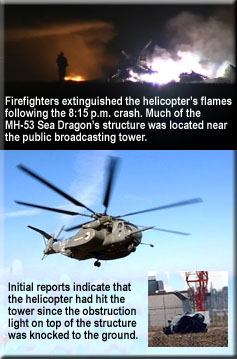 tower before it crashed nearby, killing three crew members last night at about 8:15 p.m. A third member was taken to Christus Spohn hospital where he is listed in critical condition. tower before it crashed nearby, killing three crew members last night at about 8:15 p.m. A third member was taken to Christus Spohn hospital where he is listed in critical condition.
There was heavy fog near the tower site located at County Road 59 and County Road 20 when the accident occurred. The structure is owned by Public Broadcasting affiliate KEDT.
Emergency crews said that most of the helicopter wreckage is within the guy wire footprint of the tower. A large piece of the wreckage was found at the base of the tower. The guyed tower did not collapse, but some guy wires were reportedly damaged.
Don Dunlap, president and general manager of South Texas Public Broadcasting, told KEDT radio that he went to the crash site shortly after the accident and saw parts of the antenna his station owns on the ground, and that the beacon on top had been knocked off.
The Navy crew was on a routine training mission when their helicopter went down.
Witness J.D. Batten told the Corpus Christi Caller-Times he was walking on his property about two miles from the crash site when he heard a helicopter overhead.
"I saw a red-glowing fireball shoot hundreds of feet up into the air," he told the newspaper. "I heard a giant boom a second later. It was then dead silent, and I couldn't hear the helicopter anymore."
The downed helicopter is the largest single rotor helicopter in production to date. It can remain airborne for over 12 hours due to large fuel tanks and air refueling capacities.
In May, a SH-60F helicopter on a training flight in Nevada struck a power line and crashed in a rugged area of the desert east of Reno, killing all five crew members.
|
|
I'm not a Crown Castle tech, and it doesn't look like I'll be staying in a Holiday Inn Express tonight
January 17, 2008 - At first glance it appeared to be a tower technician working on a cell tower and a ground hand assisting him in Murfreesboro, TN, on Tuesday. A 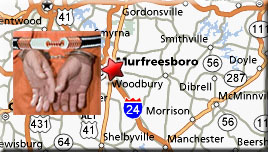 closer look by an alert sheriff's deputy found that the two men were stripping copper off the tower. closer look by an alert sheriff's deputy found that the two men were stripping copper off the tower.
When Deputy Greg Wassom, asked suspects Rodney Hall and Robert Brown why they were on the cell site, both men said that they were employed by Crown Castle International and they had been asked to remove the copper.
Wassom called Crown Castle, the company that owns the tower on Tiger Hill, and was told that they did not know the men who were then arrested. Hall and Brown were charged with criminal trespassing, attempted theft over $500 and possession of burglary tools.
|
|
One worker injured as 2,000-foot TV tower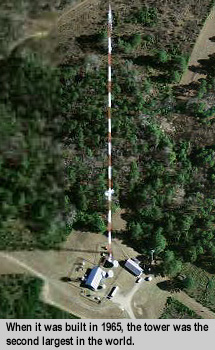
collapses in Redfield, Arkansas
January 11, 2008 - A 2,000-foot television tower collapsed while workers were replacing guy wires, knocking a Little Rock television station off the air.
KATV news director Randy Dixon said one person suffered a minor injury Friday when the tower collapsed in a field about 20 miles south of Little Rock in Redfield.
The station was working to establish a feed to restore its signal to the portion of its audience that obtains programming by satellite.
Part of the work included temporarily setting up the satellite truck at the station's Little Rock headquarters to carry the signal.
"We're off the air. It's a heck of a mess," Dixon said.
According to people present at the accident, the Structural Steel Technologies crew 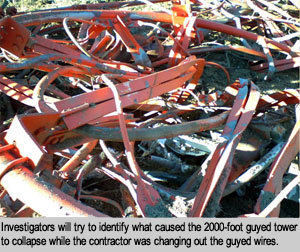 was doing a reguy. They said that it appeared that a temporary guy on the lowest level failed. was doing a reguy. They said that it appeared that a temporary guy on the lowest level failed.
Chief Deputy Sheriff Stanley James said one person who was working at the site received minor injuries when he was reportedly struck by a flailing guy wire, but he refused medical treatment.
"We're really fortunate that there was no one seriously injured when that tower went down," James said.
Built in 1965, the Dresser Industries tower was the second tallest structure in the US at that time.
The National Weather Service reported light winds during the time of the collapse.
KATV is an ABC affiliate. Click Here for additional photographs of the collapse.
|
PBS "TV Tower Safety" video is anything but safe
Update: February 11, 2008 - Following the January 8, 2008 article, the Oregon PBS station removed the video from its web site.
January 8, 2008 - A short 10-minute video by the local Oregon PBS station, entitled "TV Tower Safety," proved to be just the opposite.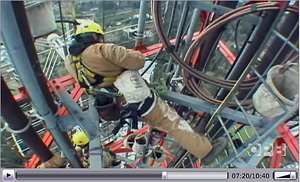
The second half of the video, broadcast in September, but recently making the rounds on Yahoo bulletin boards, features Radio Tower Company repairing a transmission line on Oregon Public Broadcasting's 1000-foot Portland tower.
Their workers appear to provide a textbook example of utilizing proper safety procedures while climbing, ensuring that lock-out-tag-out procedures are followed, and following up with RF exposure testing to verify that they can perform their work in a safe environment. 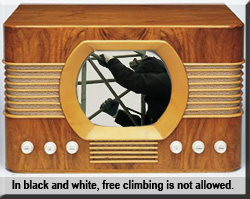
Unfortunately, the film's introduction becomes a poster child video for viewing improper climbing procedures. The station's engineer repeatedly free climbs in a remote area of Christmas Valley.
"Out here when you are by yourself, there is nothing. If you get hurt on the tower or something, you are pretty much by yourself. Any accident could be a fatal accident, so you don't want it to happen," the engineer said.
The engineer should be reminded that an accident will happen if climbers don't use 100% fall protection as required by the Occupational Safety and Health Administration.
|
|
Revision G is a go in Florida and Ohio, but stalls throughout the nation following IBC adoption
January 1, 2008 - TIA/EIA-222-G, the long-awaited revision of the structural standard for antenna supporting structures and antennas took effect January 1, 2006. Two years later the only states to adopt it are Florida and Ohio.
Since it is a voluntary standard and has no legal bearing, it only gains formidable strength when it's referenced by the International Building Code (IBC) or any other code, and that code is adopted by a permitting jurisdiction.
Unfortunately, Revision G wasn't passed in time to be reviewed and adopted by the IBC 2006 committee and Revision F remained the controlling standard. Last September the publishing of the IBC 2007 supplement made it official, Revision G is now the sanctified standard in the building code bible, but there is an excellent chance that it will not be enforced by some local jurisdictions for years to come, if ever. Please see: Adoption doesn't mandate its use
|
|
Texas erector Hang Em High receives notice of $56,900 penalty for four violations
December 28, 2007 - The U.S. Department of Labor's Occupational Safety and Health Administration announced today that it has proposed $56,900 in penalties against Berryhill Tower Services of Comfort, Texas, dba Hang Em High, for four violations of federal safety rules.
In July, an employee was fatally struck by a tower component during construction of a communications tower in Pinola, Mississippi. OSHA inspectors issued one willful violation with a $49,000 penalty against the company for allowing materials to be raised using improper rigging equipment.
"This company's primary business is working on these sorts of towers, but they knowingly used equipment that the manufacturer never intended for rigging purposes," said Clyde Payne, director of OSHA's Jackson Area Office.
The company was also cited for two serious violations with a proposed penalty of $6,400 for failing to adequately train its employees in handling rigging equipment and failing to train employees in the recognition and prevention of fall hazards. An "other-than-serious" violation with a $1,500 penalty was proposed against the company for not notifying the nearest OSHA office within the required eight hours of the employee's death.
The company has 15 business days to contest the citations and proposed penalties before the independent Occupational Safety and Health Review Commission. The site was inspected by staff from OSHA's Jackson Area Office.
OSHA and the Mississippi Associated General Contractors formed an alliance in 2004 to reduce "struck-by" accidents within the state.
|
|
Step bolt liability suit to weigh decedent's reluctance to follow OSHA's 100% tie off rule
December 19, 2007 - At first glance, a review of a recent eight count lawsuit filed against Edmiston Tower, Inc., UNR Rohn and its parent company, Radian 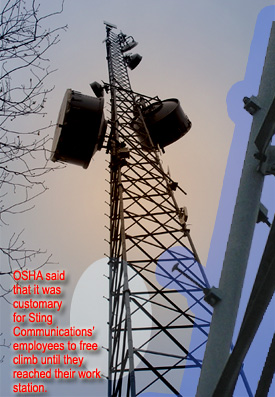 Communication Services, Inc. has the appearance of a resourceful product liability attorney championing the rights of a deceased tower technician's parents to sue the companies that they are convinced were responsible for their son's death after he fell from a 150-foot self supporting tower. Communication Services, Inc. has the appearance of a resourceful product liability attorney championing the rights of a deceased tower technician's parents to sue the companies that they are convinced were responsible for their son's death after he fell from a 150-foot self supporting tower.
A closer examination might indicate that it wasn't a product failure that was responsible for the fatality in Ebensburg, PA , but the climber's reluctance to follow proper safety requirements known to him and the failure of his employer to provide the proper safety equipment and have a written safety policy.
On Friday, May 5, 2006, Michael Sellers, 25, fell approximately 70 to 80-feet to the ground, according to a co-worker, and died after suffering numerous broken bones and massive internal injuries. The single father of two children, Daysha, now 4, and Denna, 2, was employed by Last Mile, Inc., doing business as Sting Communications, Inc.
Sting, a 20-employee company located in Lebanon that provides broadband services to rural and underserved areas of PA as well as the state's regional education network, owns approximately eight towers, including the one that Sellers fell from behind Bishop Carroll High School on school property.
Attorney Edward J. Coyle, who represents the plaintiffs, Karen A. Alexander and Gary M. Sellers, who are administrators of their son's estate, alleges that a metal "step prong" was defective and broke while Sellers was climbing the tower, resulting in his death.
According to the suit, "The aforementioned 'step-prong' is a metal prong upon or to which an individual climbing [a] tower would attach or place his hand, foot arm, leg or safety gear for support of the climber and the climber's weight."
Although the tower was originally manufactured by Rohn in the late 60s or early 70s, Edmiston Tower Inc. is a defendant, according to Charles Edmiston, owner of the Ebensburg company, because he bought the structure from a third party, had it re-galvanized, and sold it to Sting Communications during July of 2004.
Please see: Suit hinges on step bolt
|
|
Vegas monopole torched during retrofitting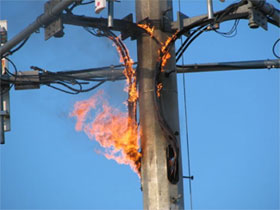
December 19, 2007 - A monopole located near the intersection of East Sahara Ave. and South Nellis Blvd. in Las Vegas, NV, was completely destroyed last Friday when a contractor set the structure's transmission lines on fire while he was reinforcing the pole.
Firefighters were concerned about an auxiliary power supply at the site and let the fire burn out while watching the surrounding area for falling embers. Ericsson Construction Manager Rylan Stewart was passing by on his way to a meeting when he was able to capture numerous photographs of the structure as it first caught on fire.
A Clark County Fire Department spokeswoman said that Alan Bunker said he was welding approximately six-feet up on the east side of the monopole when he heard a popping sound and then noticed smoke coming from the tower.
Supervisor Dave Lawless of Intellecom, the contractor working on the structure, informed fire officials that he had been in contact with T-Mobile about the incident.
|
|
Ice storm fells two Pennsylvania broadcast towers
December 17, 2007 - Two 800-foot towers crashed early Sunday morning from ice and unusually high winds knocking numerous stations off the air for many Pennsylvania viewers.
WNEP signals were knocked out as the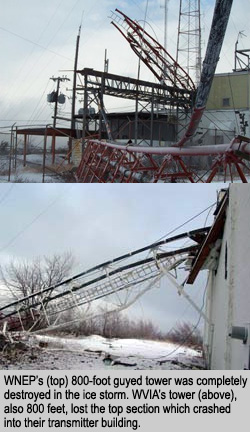 station's tower fell shortly before 7 a.m., crashing into its equipment building and damaging its digital signal equipment. WVIA's tower was also snapped, losing its top sections. The towers are located on Penobscot Mountain in Luzerne County. station's tower fell shortly before 7 a.m., crashing into its equipment building and damaging its digital signal equipment. WVIA's tower was also snapped, losing its top sections. The towers are located on Penobscot Mountain in Luzerne County.
WNEP, the ABC affiliate, was the first and worst hurt, sending station managers and engineers scrambling for temporary solutions. A weakened WNEP digital signal was restored by 2 p.m., feeding either directly or via airwaves to cable and satellite companies who rebroadcast the channel.
Ice build-up and wind snapped WVIA's tower in half, but the station was able to continue transmitting on a weaker signal, said Bill Kelly, WVIA president and CEO. They are able to operate their FM station because the tower break happened above the broadcast antennas. WVIA analog TV is now telecasting from an older, smaller tower they own on the mountain.
Penobscot Mountain is a familiar nighttime site to those in the Wyoming Valley or heading south on Route 309 between Wilkes-Barre and Mountain Top. The mountain ridge is home to a row of broadcast towers that appear as stacks of red lights at night.
|
|
New Jersey man succumbs following fall
December 6, 2007 - A tower technician employed by JBL Electric, Inc. of Totowa, NJ, fell to his death yesterday afternoon while installing coaxial lines on a Public Service Electric and Gas transmission line tower.
The accident, the tenth industry fatality this year, occurred in Bridgewater.
Officials say Arthur Crane, a 45-year-old Stanhope resident, fell from approximately 80 feet. One of Crane's two co-workers immediately called 911. Crane was pronounced dead at the scene. His body was transported to the New Jersey State Medical Examiner's office.
The New Jersey Office of Public Employees Occupational Safety & Health (PEOSH) will investigate the fatality.
|
|
OSHA issues final rules on personal protective equipment required to be paid for by employer
November 29, 2007 - Beginning February 13, 2008, employers will be responsible for providing personal protective equipment for their workers.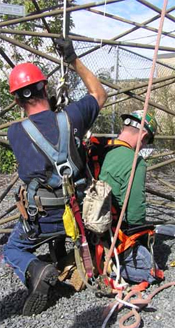
The new rule, released November 15, 2007, requires employers to supply safety equipment to workers only when complying with Occupational Safety and Health Administration regulations.
The final rule includes several exceptions so that employers do not have to pay for safety equipment such as work boots, prescription safety glasses and goggles, and any weather-related clothing.
OSHA said that if the employee does not return the employer's equipment, nothing in the final rule prevents the employer from requiring the employee to pay for it or take reasonable steps to retrieve the PPE, in a manner that does not conflict with federal, state or local laws concerning such actions.
In these situations, OSHA notes that the employer is not allowed to charge the employee for wear and tear to the equipment that is related to the work performed or workplace conditions such as painting a communications tower.
OSHA will allow for a deposit system that provides an incentive for employees to return the equipment. However, the Agency cautions that the deposit system must not be administered in a fashion that circumvents the rule and results in an employee involuntarily paying for his or her PPE.
Allowing employees to provide their own PPE can be an acceptable practice as long as the employees are provided the PPE assessment for their workplace and the minimum guidelines for the selection of the PPE.
An employer that hires an independent contractor is not required to pay for the contractor's safety equipment according to the OSH Act.
In 1997, OSHA first announced that the agency was developing the PPE rule; it issued the proposed regulations in March 1999. While the final rules include several clarifications from the original proposals to reflect changes in the employment laws and to update minor changes in protective equipment, the regulations will provide workers no less safety protections than under the original 1999 proposal, OSHA officials say.
Many tower companies require their employees to use company-provided safety equipment. Others will allow employees to use their personal equipment as long as it meets written company standards.
|
|
Power backup requirement suit filed by CTIA
November 26, 2007 - Wireless trade association CTIA has filed a legal challenge against the Federal Communications Commission in the U.S. Court of Appeals for the District of Columbia Circuit. The industry group has asked the federal appeals court to overturn a new federal mandate setting minimum requirements for backup-power sources at cell sites and other wireless facilities, stating the government overstepped its legal authority in attempting to address communications problems caused by Hurricane Katrina in 2005.
|
|
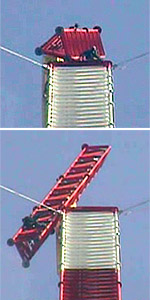
Crew safely tops out guyed tower near Daytona Beach at 1,499 feet
November 12, 2007 - Superintendent Kenny Singleton carefully watched the exacting operation of setting a 90' antenna mast on top of a 1,409-foot guyed tower early Saturday morning. Unlike other projects safely managed by the veteran erector, this time he was joined by over 6,000 viewers who also watched Tower King II's crew top out the guyed tower west of Daytona Beach, FL. Additional tens of thousands more people will view the time lapse video of the November 10 mast setting.
This first real time viewing of tower construction has provided the industry with a close up presentation of the many professional disciplines necessary to erect a tall communications tower. The WirelessEstimator.com project was made possible through the assistance of Hark Tower Systems, Stainless LLC and Tower King ll.
The crew is currently installing elements of the Cox Radio Group's FM antenna. The installation project has elicited numerous questions from workers within the industry.
|
Licensing climbers might help to stem the continued increase in industry fatalities
by Winton W. Wilcox Jr.
November 1, 2007 - Last February, Gritz Towers' management and employees struggled with a severe personal and emotional crisis when an employee died after falling from a 330-foot self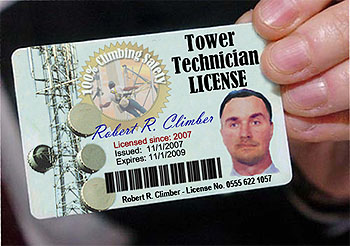 supporting tower in Louisiana. supporting tower in Louisiana.
Less than six months later, they were devastated when another employee from Texas fell approximately 300 feet to his death, also in Louisiana.
After conducting thorough investigations following each accident, the Occupational Safety and Health Administration decided not to cite Gritz Towers for any workplace safety violations; after all, the company had provided its employees with adequate training and safety equipment, and had done everything right. But, despite these findings, the resolute burden of Gritz's management burns daily as they question whether this accident was preventable.
Perhaps now is the time for an industry-wide focus on tower climber safety and a collective effort by all companies involved in the construction infrastructure working to add an additional component to certification of tower climbers - licensing.
Please see: Could licensing have made a difference? |
|
New eight hour rule will require power backup at all cell sites for every carrier
October 16, 2007 - FCC Commissioner Jonathan Adelstein informed industry executives attending the PCI - The Wireless Infrastructure Association conference on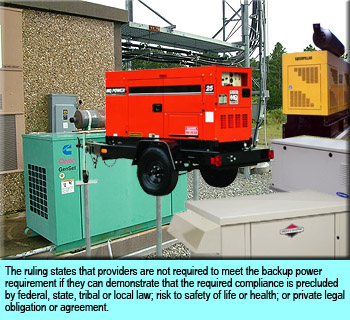 October 2 in Orlando ( see prepared text ) that their success will help to fuel the country's economic growth and public safety. October 2 in Orlando ( see prepared text ) that their success will help to fuel the country's economic growth and public safety.
On the same day in Washington, the Federal Communications Commission said that to meet national concerns for adequate public safety communications, it had adopted an order reinforcing and clarifying a prior order requiring cell phone and landline carriers within one year to install power backup supplies at all of their sites and to have portable power supplies available for sites that are incapable of having power backup.
The ruling will clearly benefit the economic growth of generator, battery and fuel cell suppliers as well as installation contractors throughout the country. Public safety will be the prime beneficiary, but carriers and other telecom companies will be burdened with considerable expenses that will be incurred in order to meet the FCC's deadline -- impacting Adelstein's wished for success.
The Commission's safety edict will result in increased administrative costs to tower owners to manage the new power supply installations that will ensure eight hours of power backup, but they will benefit from increased lease rates as their tenants expand their compound footprint.
Please see:Veiled carrier threats oftentimes ignored
|
|
Quick repairs to put country music station's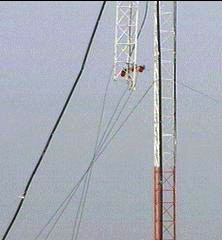 downed tower up again downed tower up again
October 15, 2007 - A gust of wind from storms today resulted in a partial collapse of a 300-foot guyed radio tower in Henderson County, TX .
Approximately 100-feet of the 25-year-old structure collapsed, but remained attached to the rest of the tower.
The damage knocked country music station KCKL 95.9 off the air. The station had a crane on the scene for re-construction within a few hours, and they hope to be back on the air Tuesday, a station spokesperson said.
|
|
Real time viewing of 1,500-foot guyed tower's erection in Florida is an industry first
October 5, 2007 - Through the joint effort of Hark Tower Systems, Stainless LLC, Tower King ll and WirelessEstimator.com, real time viewing of the construction of a 1,500-foot guyed tower near Daytona Beach, Florida, will be presented until the project is completed.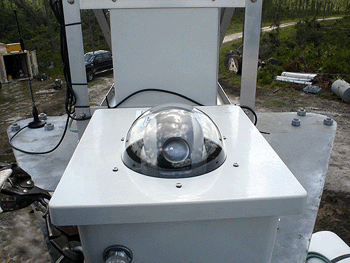
Cox Radio Group awarded Stainless the project to replace their broadcasting tower that was knocked down during a tornado in February of 2007.
The nine guy anchor foundations were not damaged during the structure's collapse, but the base was retrofitted to accommodate the new tower. Sophisticated computer wind modeling techniques were employed to ensure the safety of the new design under the most unusual environmental conditions.
This is the first time that the nation will be able to view, in real time, the construction of a tower on the internet, and it should prove to be especially interesting to the large audience of people who are intimately involved in the industry, but have never had the opportunity to witness the exacting disciplines, equipment and procedures required to safely erect a tower.
Joining this industry first is another milestone. This is the first tall broadcast tower erected in the country that has been designed using TIA-EIA 222-G, the nation's newest tower standard that became effective January 1, 2006.
Florida is currently the only state where Revision G is legally applicable. The 2004 Florida Building Code was amended December 8, 2006 referencing the newest revision of the structural standard.
Please see: Real time tower construction viewing
|
|
Staggering results: Monopole wind testing identifies overly conservative design calculations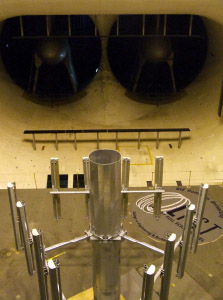
By Brad Cook, P.Eng.
September 26, 2007 - With the continuous growth in the wireless industry, there has been a demand to continually upgrade existing tower structures, pushing them to their limit, while just satisfying the latest structural TIA and IBC code requirements.
For guyed and self supporting towers, the analysis procedure has been time tested and upgrades routine; however, for monopoles, being fairly new to the tower industry (last 15 years), this has not been the case.
There has been wind tunnel testing on monopoles and various types of individual antennas but no known testing has been completed to date on the effects of wind around full platform arrays with and without antennas (degree of shielding), along with transmission lines and reinforcements banded up the outside of monopoles (change in drag coefficients). With no prior information readily available, it has been the engineer’s discretion on how to treat such cases until now.
|
PCIA Orlando seminar to explore prevention of structural failures
Brad Cook will be a guest panelist at a PCIA presentation at the association's annual conference in Orlando, FL on Thursday, October 4 from 10:00 a.m. until 11:15 a.m.
He'll be joined by David Brinker, Bill Garrett, Bill Griswold, Jim Kyriacopoulos, Chris Mallon, and Jim Hopkins who will discuss new standards and innovative techniques for the prevention of structural failures.
These expert engineers will discuss TIA-EIA Revision G, focusing upon how the new standard has changed load carrying capacity.
The panel will also turn its attention to testing cracks on monopole sections and how base plate design modifications can prevent future problems. Conference details for the wireless infrastructure show are available here .
|
On January 17 through 20, 2006, Structural Components completed the first ever full scale wind tunnel testing on various 20-foot monopole sections, mounts, as well as transmission lines and structural reinforcements attached up the outside of poles to help understand the true behavior of wind flow and drag. The objective: to gain accuracy and confidence in the structural analysis of monopoles with all the various appurtenances being added to them.
The full scale wind tunnel testing was completed at a 60-foot wide by 30-foot tall open wind tunnel facility at Langley Full Scale Testing (LFST) in Hampton, VA. Wind speeds ranged from 35 mph (just after subcritical flow) to upwards of 75 mph (supercritical flow). The testing was attended by major tower owners, tower manufacturers and consulting engineers. ...
Please see: Results contradict current design calculations

|
|